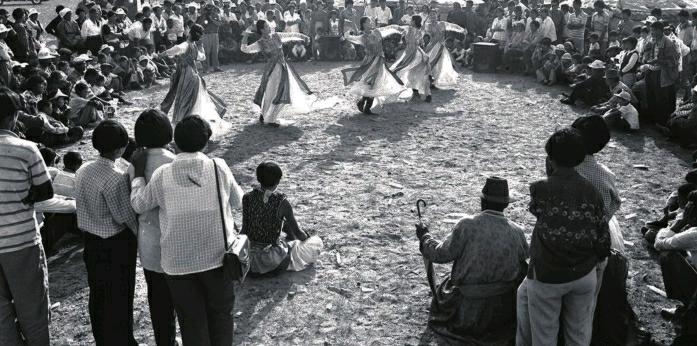The Nomadic Art
2018-02-09ByPanXiaoqiao
By+Pan+Xiaoqiao
The people living on the grassland of north Chinas Inner Mongolia Autonomous Region are born with a passion for art, expressing themselves through song and dance. However, herders live a life of loneliness cut off from the outside world, and they can only sing to the sky and dance with their livestock. Fortunately, the Ulan Muqir troupes are on hand to enrich their lives.
Ulan Muqir means “red bud” in the Mongolian language. It is a type of traveling troupe organized by the local government, born and rooted in the grassland, and serving its local people. When the first Ulan Muqir troupe was established in 1957 it had only nine members, while today 75 such troupes are made up of more than 3,000 members. They dance, perform dramas and play musical instruments for herders who live in remote areas in the huge expanse of the steppe, while living alongside them over a period of weeks or sometimes months. A traveling troupe may be small, but its members must be good at performing local songs and dances as the Ulan Muqir troupes form the major public cultural service in the pastoral and farming regions of Inner Mongolia.
On November 21, 2017, President Xi Jinping wrote a letter to the Ulan Muqir in Sonid Right Banner, a county in central Inner Mongolia Autonomous Region.
“In the new era, I hope you can carry forward the fine tradition of the Ulan Muqir, put down roots, and serve the herders,” Xi said in the letter.
As news spread of this letter from the president, people began to direct their attention toward these special traveling troupes.
Humble beginnings
In the 1950s, local herders and farmers lived a dull life in terms of culture, their residences scattered across the grassland, far from each other, and with poor means of transport and communication to depend on. This isolated life left the nomads barely aware of news elsewhere in the country. The Culture Bureau of the Inner Mongolia Autonomous Region thus decided to set up a small traveling group to enrich the herders cultural life and promote the governments plans.
On June 17, 1957, the first Ulan Muqir traveling troupe was established in the Sonid Right Banner, Xilin Gol League of Inner Mongolia Autonomous Region. Their equipment included two big wheel carts, two backdrops, two tents, three kerosene lamps, four costumes, five musical instruments, six horses, a radio and a gramophone. All nine members of the troupe could dance, sing and play musical instruments, and they were able to inform the locals of outside news and policies issued by the government through short programs.endprint
Inner Mongolia covers an area of more than 1.18 million square km, composed mainly of pastures, tree farms and mining areas. The troupe often had to travel for several days before reaching their destination, even if sometimes their audience was just one family living in one yurt on the plains. The traveling was hard going, but the Ulan Muqir remained dedicated to their cause.
The endeavors of the first Ulan Muqir spurred the creation of other traveling troupes, and by the end of 1963, Inner Mongolia was home to 30 such groups. At the end of 1964, Chairman Mao Zedong and Premier Zhou Enlai met with representatives from these Ulan Muqir troupes and praised them for their contributions to local society and culture, prompting the Ministry of Culture to organize an Ulan Muqir tour across 27 provinces, municipalities and autonomous regions around the country over the course of seven months. These shows helped to shoot the Ulan Muqir to stardom nationwide and in the years since they have set up tens of thousands of art programs, while cultivating a large number of new artists.
Serving the people
For six decades, the Ulan Muqir troupes have been dedicated to entertaining and educating herders and farmers.
Meng Yuzhen, a troupe leader from the Xilin Gol Leagues Ulan Muqir, recalls how in the 1980s members performed in the open space of farmhouses or yurts by pulling a backdrop behind, with oil lamps burning either side. Despite the harsh conditions, the audience was very passionate, and in return the Ulan Muqir teams would strive to reach every herder in every corner of Inner Mongolia, no matter how adverse the conditions, so that everyone had a chance to watch their performance.
The Ulan Muqir played an important role in helping to deliver important news and information to their audiences, and most of their programs were written and performed by themselves, with relevant ethnic and regional features. Songs were favored as a way to promote cultural and social values, and to make them more accessible for their audiences.
Most members of the Ulan Muqir come from local families, and so they are often deeply rooted in the culture and tradition of the grassland. Wherever they travel to perform, they live and work alongside the local herders and farmers. In their capacity as performers they entertain, but they also try to help local people in any way they can, by buying books from cities and restoring farm tools.endprint
Jin Hua, an ethnic Mongolian soprano and a member of the first Ulan Muqir team of 1957, said in an interview that the “herders and farmers were very kind and hospitable to us wherever we went to perform. They invited us into their homes and offered to share their food and drink which were already insufficient to feed their families. Today I still feel the warm bonds between the herders and the Ulan Muqir.”
Ulan Muqir troupes have also played a role in Chinas poverty alleviation campaign. On one occasion, upon discovering that a village was lacking in pasture due to drought, the local troupe donated money to help dig a well for the villagers, providing them with a badly needed supply of water.
Keeping up
Nowadays, technology has greatly reduced the distance between remote villages and cities, and the Ulan Muqir troupes are going to great lengths to keep pace with the changing times. Spreading the ethnic culture nationwide has become a new focus for the troupes.
Since 2003, some Ulan Muqir troupes have been extending their range beyond Inner Mongolia, organizing shows in cities such as Beijing and Shanghai. Some have even traveled abroad to perform in commercial shows in countries such as Thailand, Germany and Belgium, where they have received both plaudits and an economic boost.
The Erguna River, mother river for north Chinas nomadic people and now the boundary between China and Russia, has also become an important stage for the Ulan Muqir. The troupe there has created many folk performances and programs by combining traditionally Russian styles with local features. Now the group presents shows on a stage above the river for Chinese and Russian audiences in July and August each year. It has become an important bridge of cultural communication between the people on either side of the border.
By the end of 2017, the Ulan Muqir troupes had traveled 1.1 million km, having put on more than 300,000 shows with a total audience of 212 million people. The troupes are of great significance to Inner Mongolias cultural development.
Na Shun, head of an Ulan Muqir troupe under the auspices of the Peoples Government of Inner Mongolia Autonomous Region, told Xinhua News Agency that “in the past 60 years, the Ulan Muqir troupes have always stuck to the principle of being close to the people.”
Na said that his troupe has created more than 1,000 songs, episodes and dance and folk art programs, all full of Mongolian ethnic features and local fl avor.
“Our stage is always the vast grassland of Inner Mongolia and the herders are our audience. Today, we travel by cars not by horses but we will carry forward the Ulan Muqir tradition and serve the people forever,” Na said.
“The Ulan Muqirs shows are always based on the realities of life on the grassland,” Lei Dongxiang, head of the Erguna Ulan Muqir, said.
“We see this as our roots and the direction in which we should continue to head,” Lei said.endprint
